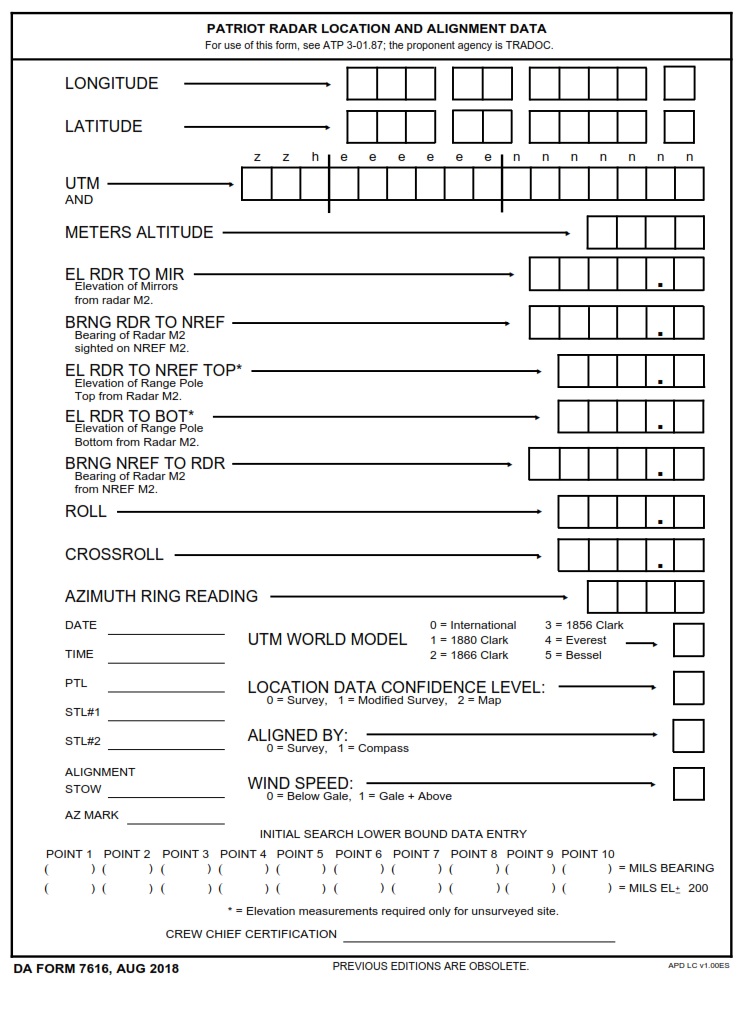Table of Contents
FREE-ONLINE-FORMS.COM – DA Form 7616 – Patriot Radar Location And Alignment Data – In the realm of military defense systems, precision, and accuracy can truly be a matter of life or death. One such critical component in the arsenal of the United States Army is the Patriot Radar system, a formidable force against aerial threats. However, behind this technologically advanced shield lies an equally vital tool: DA Form 7616 – Patriot Radar Location and Alignment Data. This seemingly unassuming document holds the key to ensuring that these radar systems are optimally placed and aligned for maximum effectiveness, providing commanders with invaluable information for safeguarding our skies.
Download DA Form 7616 – Patriot Radar Location And Alignment Data
| Form Number | DA Form 7616 |
| Form Title | Patriot Radar Location And Alignment Data |
| Edition Date | 8/1/2018 |
| File Size | 34 KB |
What is a DA Form 7616?
The DA Form 7616 is an essential document used by the U.S. Army to collect and record the Patriot Radar location and alignment data. The data collected on this form serves as a critical component in ensuring the accuracy and efficiency of the Patriot missile defense system. It provides detailed information about the radar’s location, azimuth, elevation, slope, and other important parameters that are crucial for its proper functioning.
This form plays a vital role in maintaining operational readiness for Patriot systems deployed around the world. By accurately recording and documenting the radar’s precise location and alignment data, military personnel can ensure that each system is optimally positioned to detect and track incoming threats accurately. These crucial steps help safeguard not only soldiers’ lives but also critical assets such as military bases, infrastructure installations, and civilian populations.
In addition to its practical application in military operations, the DA Form 7616 highlights an underlying aspect of modern warfare – technology integration. As part of a sophisticated missile defense architecture like the Patriot system, every component must be precisely coordinated with others to create a synergistic effect against potential threats. The accurate collection of radar location and alignment data exemplifies how advanced technologies like radar systems work together as a unified force to protect national security interests effectively.
Overall, understanding the significance of DA Form 7616 goes beyond just appreciating its administrative function; it sheds light on the intricate processes involved in protecting our armed forces personnel while serving as a testament to our commitment to employing cutting-edge technology in safeguarding national interests.
Where Can I Find a DA Form 7616?
If you are a member of the U.S. Army or operate within its realms, you may find yourself in search of various forms and documents to complete your duties efficiently. One such form is the DA Form 7616, which plays a crucial role in gathering data for the Patriot Radar Location and Alignment process. But where can you find this elusive document?
Thankfully, it is an easily accessible form that can be found on several platforms. The official source of all U.S Army forms is the Army Publishing Directorate website (www.apd.army.mil). Here, you can browse through an extensive collection of forms, including DA Form 7616. It’s important to note that this website provides not only downloadable versions but also online fillable templates for convenience. Furthermore, users can search for specific forms using their designated form number or by entering related keywords.
In addition to the official Army Publishing Directorate website, other reliable sources offer access to DA Form 7616. Websites such as usarmybasic.com provide easily navigable repositories of various military forms and documents specifically designed for easy accessibility by soldiers and personnel in need. These platforms understand the value of time and efficiency when it comes to finding essential paperwork promptly.
By knowing where to find a DA Form 7616 swiftly, military personnel can save valuable time navigating through bureaucratic obstacles while ensuring they have accurate radar location and alignment data at their fingertips when needed most.
DA Form 7616 – Patriot Radar Location And Alignment Data
The DA Form 7616 plays a crucial role in ensuring the effectiveness and accuracy of the Patriot radar system. The form contains detailed information regarding the location and alignment data, which are essential for the successful operation of this advanced military technology. By recording vital parameters such as latitude, longitude, elevation, and antenna height, this form helps to determine the precise positioning of each radar unit. This information is then used to ensure that all units within a network are properly aligned and synchronized – a critical factor in achieving optimal performance.
Accurate location and alignment data provided by DA Form 7616 not only improves operational efficiency but also enhances overall readiness. During military exercises or real-world scenarios, having well-aligned Patriot radar systems can mean the difference between success and failure on the battlefield. By maintaining consistent alignment across all units within a network, commanders can rely on reliable target-tracking capabilities from multiple angles simultaneously – a pivotal advantage in modern warfare.
In conclusion, DA Form 7616 is more than just another bureaucratic necessity; it serves as an indispensable tool for optimizing the performance of Patriot missile radar systems. With its ability to capture accurate location and alignment data, this form ensures that each radar unit is configured correctly to deliver enhanced situational awareness on the battlefield. Ultimately, by providing valuable insights into critical technical aspects of deployment planning and operations execution, DA Form 7616 contributes significantly to maximizing combat effectiveness while safeguarding our national security interests at home and abroad.
DA Form 7616 Example
